8 Strategies to Improve Time-to-Resolution in 2025
Time to resolution is a metric that tracks exactly that. It measures the average time from when a customer contacts support to when their problem is fixed. Lower TTR means happier customers.

Time to resolution is a metric that tracks exactly that. It measures the average time from when a customer contacts support to when their problem is fixed. Lower TTR means happier customers.

Do you feel like you’re constantly struggling to stick to your New Year’s resolutions? Are you tired of setting goals and never achieving them? It may be time to rethink your approach to resolutions.
Every year, millions of people set resolutions with the intention of making positive changes in their lives. Studies show that only 8% of people follow through with their resolutions. The cycle of setting and abandoning resolutions can be discouraging.
Understanding the reasons why resolutions fail and implementing effective strategies for success can turn your aspirations into reality. It’s time to make this year the year of resolution success.
Time to resolution refers to the amount of time it takes for a customer issue to be fully resolved. The metric is crucial in measuring the efficiency of a company’s customer support team. Longer time to resolve can lead to dissatisfied customers and potentially damage the brand’s reputation. Tracking and improving the resolution time can ensure customer satisfaction.
The metric acts as a diagnostic capability for identifying bottlenecks in your support workflow, much like how a thermometer reveals the health of a patient. Companies that consistently monitor resolution times can proactively address systemic issues, implement better training programs and optimize their ticketing systems to create smoother customer experiences.
Key objectives:
Explore the significant advantages of improving your time to resolution and how it can transform not just your workflow, but your entire organizational culture.
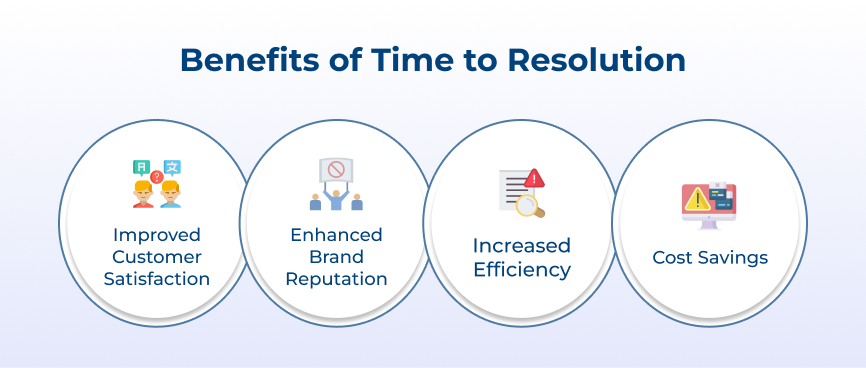
One of the key benefits of reducing time to resolution is improved customer satisfaction. When customers have issues, they want them addressed quickly. Resolving issues on time can ensure that your customers are happy and satisfied with your services. 72% of customers want immediate service.
Efficiently resolving issues can also help to enhance your brand reputation. Customers appreciate proactive responses, enhancing their perception of your brand positively. It can help to build trust with your target audience, leading to a stronger brand reputation.
Reducing time to resolution can also help to improve efficiency within your digital marketing team. When issues are resolved quickly, less time is spent on troubleshooting. It can lead to increased productivity and better performance in your marketing campaigns.
Resolving issues on time can also save money for your business. Protracted resolution times can lead to increased costs associated with customer service. Addressing issues quickly can minimize costs and keep your expenses under control.
alculating the TTR accurately can help in identifying bottlenecks in your support process and improving customer satisfaction. Here are the key components required for calculating time to resolution:
Key Components:
Formula:
TTR = Resolution Time – Initial Reporting Time
Steps to Calculate TTR:
Step 1: Determine the initial reporting time: The timestamp when the customer reports the issue to your support team. It could be through a phone call, email, chat, or any other channel.
Step 2: Determine the resolution time: The timestamp when the support team marks the issue as resolved or closed. It signifies the point when the customer is informed of the resolution.
Step 3: Calculate the TTR: Subtract the initial reporting time from the resolution time to get the time to resolution.
Example:
Let’s say a customer reports an issue at 10:00 AM, and the support team closes the ticket at 2:00 PM on the same day. The calculation would be as follows:
Initial Reporting Time: 10:00 AM
Resolution Time: 2:00 PM
TTR = 2:00 PM – 10:00 AM = 4 hours
The TTR would be 4 hours. Tracking TTR for different tickets can identify patterns, optimize support processes and improve customer service efficiency.
The following are the effective strategies that can help your business minimize the time to resolution, ensuring your customers feel valued and heard.
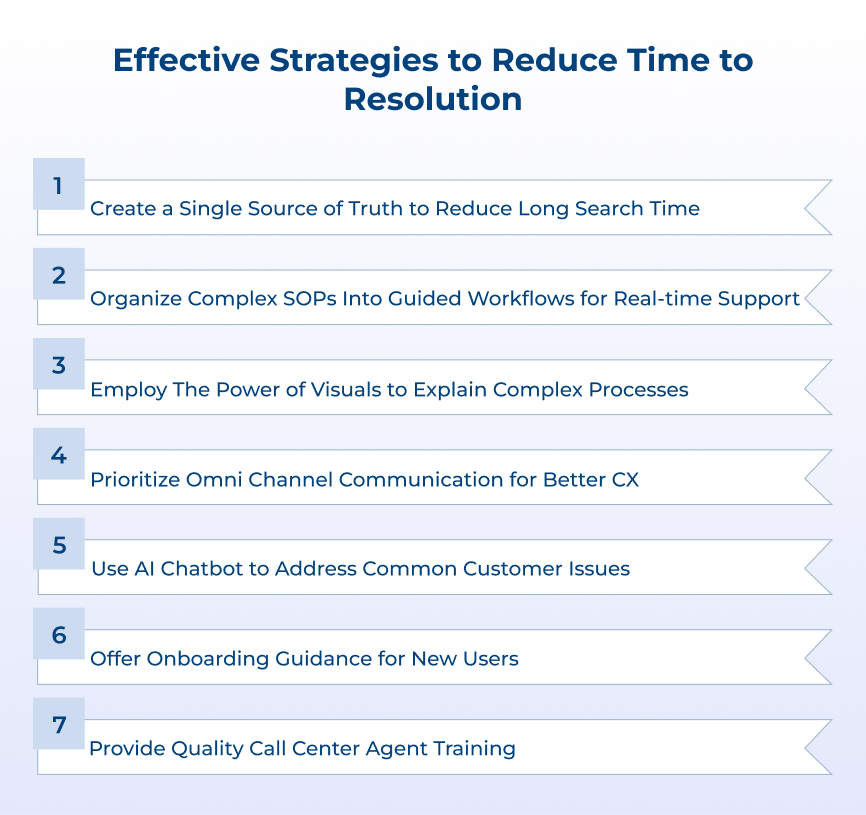
Creating a single source of truth is an effective strategy to reduce your time to resolution. The approach involves consolidating all relevant data into one centralized platform. It makes it quick and easy to access the information needed to solve a problem or answer a question.
Let’s assume that a company could create a centralized knowledge base that includes troubleshooting guides, FAQs and relevant documentation. The knowledge base would serve as the single source of truth for all employees. It helps them quickly find the information they need to address customer inquiries or technical issues.
Pro tips:
Having an efficient process in place to quickly resolve issues is crucial for businesses. Support agents can navigate through the process by breaking down complex SOPs into step-by-step guided workflows. It saves valuable time and reduces errors. The strategy ensures that agents have clear instructions at their fingertips, enabling them to swiftly assist customers.
Let’s consider that a customer service team at a software company implemented the strategy by creating guided workflows for troubleshooting common technical issues. Agents were able to quickly resolve issues by organizing troubleshooting steps into a user-friendly interface. It led to a significant reduction in time to resolution.
Pro tips:
Effective communication is key in any business, especially when dealing with complex processes that require explanation. Using visuals such as diagrams, flowcharts, or infographics can streamline the explanation process. Visuals can break down complicated concepts into easily digestible parts, making it easier for everyone to grasp the information quickly.
Let’s say a customer service representative is trying to explain a troubleshooting process to a frustrated customer over the phone. Using a visual flowchart to guide the customer can help communicate the process clearly, reducing the time it takes to resolve the issue.
Pro tips:
Prioritizing omnichannel communication is an effective strategy to reduce your time to resolution. It involves using multiple channels to ensure streamlined communication with customers.
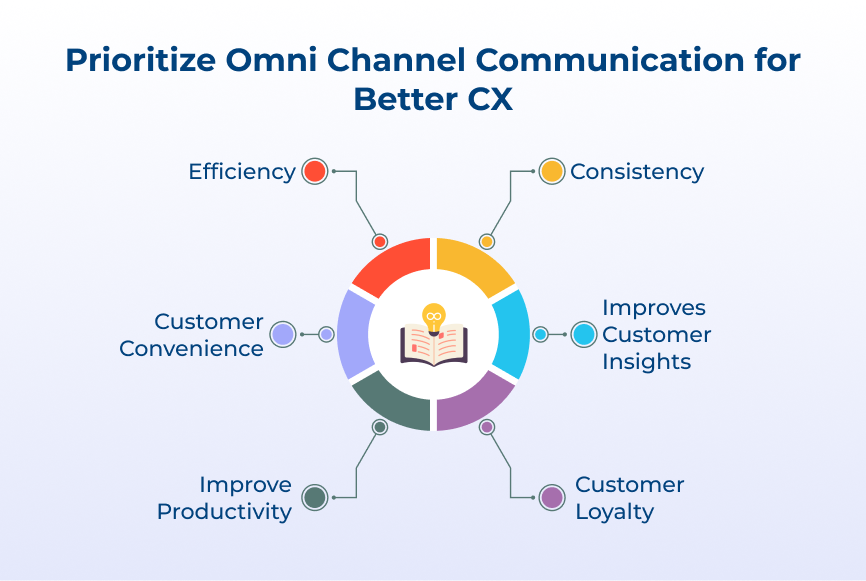
One unique aspect of the strategy is that it allows customers to reach out through their preferred channels. Brands with strong omnichannel customer engagement retain an average of 89% of their customers
Let’s assume that a customer reaches out via social media. Your team can quickly respond and resolve the issue without the need for the customer to switch to a different channel.
Pro tips:
AI chatbots are computer programs that use artificial intelligence to simulate conversations with human users. It provides quick and efficient solutions to customer inquiries. The unique thing about the strategy is that AI chatbots can work 24/7, responding to customers at any time. Customers do not have to wait for a human agent to be available to address their concerns, resulting in a shorter on time resolution.
Let’s consider that a company in the e-commerce industry implemented an AI chatbot on its website to assist customers with order tracking and inquiries. The chatbot efficiently managed multiple inquiries, reducing customer issue resolution time significantly.
Pro tips:
Offering onboarding guidance for new users is an effective strategy to reduce the time to resolution in customer service. Providing clear instructions to new users can minimize confusion and empower users to navigate their products or services efficiently. One unique aspect of the strategy is its focus on proactive communication. Rather than waiting for users to encounter issues and reach out for support, reducing the likelihood of future problems arising.
Let’s assume that a software company may create a series of interactive tutorials and walkthroughs to help new users familiarize themselves with the platform. Guiding users through functionalities can prevent common user errors and streamline the learning curve.
Pro tips:
Providing quality call center agent training is crucial in reducing time to resolution and ensuring customer satisfaction. It involves equipping agents with the necessary skills to efficiently handle customer inquiries leading to quicker resolutions. They are better equipped to address customer concerns promptly by continuously updating agents on new products and services.
Let’s consider that a company implemented a comprehensive training program that included role-playing scenarios and customer service etiquette workshops. The call center agents were able to resolve customer issues 20% faster than before.
Pro tips:
Below are the major challenges that contribute to extended resolution times, exploring how businesses can identify and overcome these barriers to improve their service outcomes.
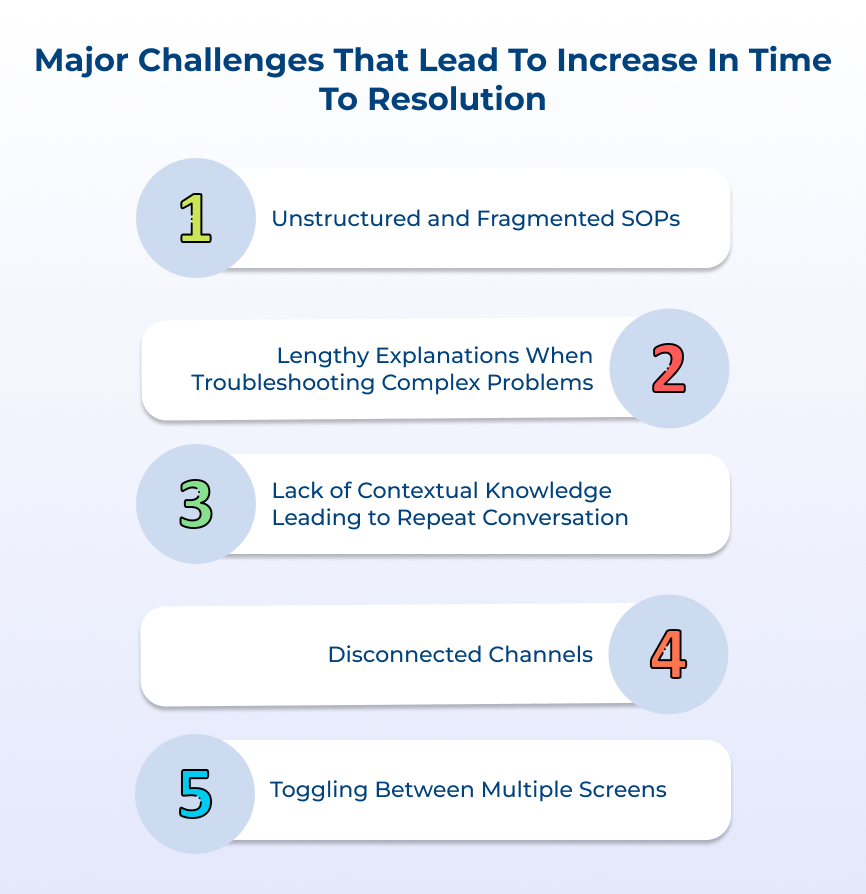
Standard Operating Procedures (SOPs) are essential guidelines for troubleshooting and resolving issues efficiently. When SOPs are unstructured or fragmented across different documents or departments, it can be time-consuming to find the right information. Companies should invest in a centralized knowledge management system that organizes and updates SOPs in a user-friendly format.
When dealing with complex technical issues, support agents may need to provide detailed explanations to customers, which can prolong the resolution time. Companies can invest in training programs that focus on communication skills for simplifying complex technical concepts.
When support agents lack complete information about previous interactions with a customer, it can result in repeat conversations and delays in issue resolution. Implementing a customer relationship management (CRM) system that tracks customer support interactions and history can help agents provide efficient support.
Customers expect seamless transitions between different channels such as phone, email, chat and social media. When channels are disconnected or lack integration, it can lead to delays in resolving customer issues. Companies should invest in a unified customer support platform that integrates all communication channels to provide a consistent and efficient support experience.
Support agents often need to access multiple systems and applications to gather information or troubleshoot issues, leading to distractions. Companies can invest in a single, unified interface that consolidates relevant information in one place. It helps in reducing the need for agents to switch between multiple screens.
Below are the key aspects you should consider when setting and evaluating these benchmarks to ensure your operations are both effective and efficient.
Understanding the customer expectations is crucial when it comes to resolving issues. Some customers may expect a quick resolution, while others may be more patient. Knowing what timeframe your customers expect can help set a realistic target.
Different issues may require varying levels of effort and resources to resolve. It is essential to consider the complexity of the issue and the amount of work involved in resolving it. It will help to ensure that your target is achievable and realistic.
Awareness of your competitor’s speed in solving similar issues is crucial. It can give you a benchmark to compare against and help you set competitive time-to-resolution targets. Knowing what your competition is doing can help you strive to provide even better customer service.
Below are the ideal average on time resolution across different channels, equipping you with the insights needed to streamline your customer support processes effectively.
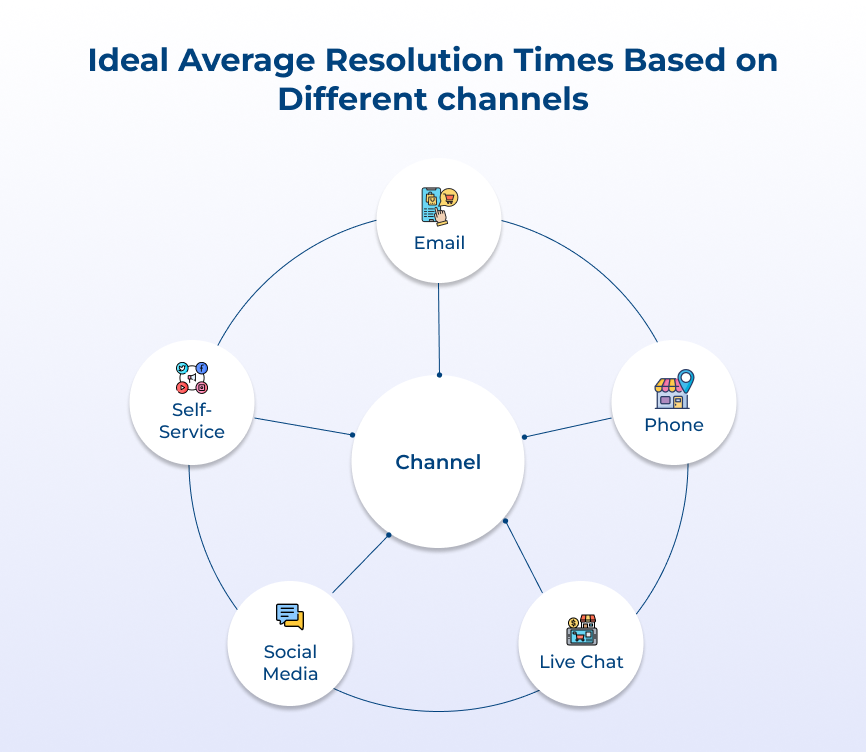
Email is a popular customer service channel, but it can sometimes have longer average resolution times compared to other channels. The average resolution time for email inquiries is within 12 hours. It allows for a timely response to customer inquiries. It also allows customer service agents to provide a thorough and thoughtful response.
Phone support is often preferred by customers who require immediate assistance. The ideal resolution time for phone inquiries is usually within a few minutes. Customers expect to speak with a live agent quickly when they call for support. Having a short wait time and efficient handling of the call is essential for providing a positive customer experience.
Live chat support is gaining popularity as a customer service channel due to its convenience and real-time interaction with customers. The ideal resolution time for live chat inquiries is typically within a few minutes as well. Customers using live chat expect immediate responses to their queries. Having well-trained agents available to handle chat inquiries promptly is key.
Social media is a fast-paced channel where customers expect quick responses. The ideal resolution time for social media inquiries is within a few business hours. Businesses need to monitor their social media platforms regularly and respond to inquiries promptly.
Self-service options, such as FAQ pages or knowledge bases, are ideal for providing quick and easy solutions to common issues. The ideal resolution time for self-service inquiries is immediate, as customers can access the information they need on their own time. Offering self-service options can empower customers to find answers to their questions quickly and efficiently.
Ready to enhance your company’s ability to resolve issues swiftly and effectively? Let’s explore five best practices that could revolutionize your approach to resolution time management.
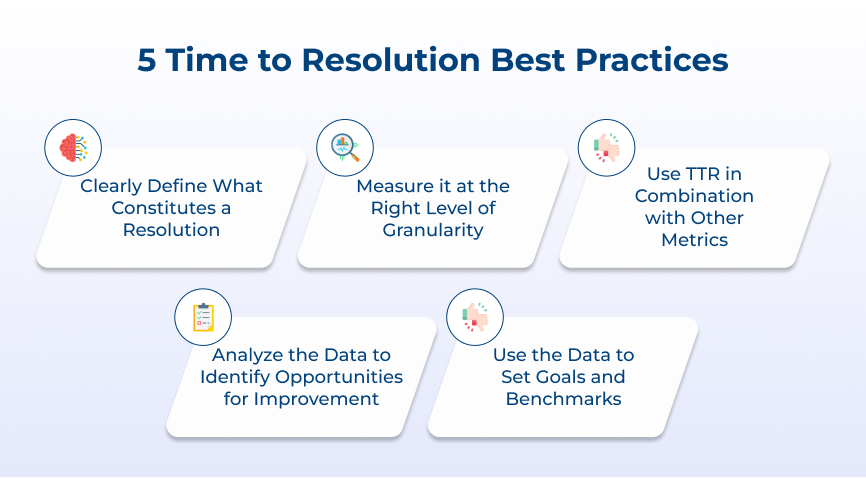
Before you can accurately measure the time to resolution, you need to have a clear definition of what constitutes a resolution. The definition should align with the specific goals of your customer support team and should be communicated clearly to all team members.
Measuring the TTR at the right level of detail is crucial to get an accurate picture of your team’s performance. It might mean breaking it down by individual support agent, by type of issue, or by customer segment. Measuring TTR at the appropriate level of granularity can identify areas for improvement and make targeted changes to your support processes.
While time to resolution is an important metric, it should not be used in isolation. It’s essential to also track other key metrics such as customer satisfaction scores and retention rates. Analyzing the metrics in conjunction with TTR can help get a more comprehensive view of your team’s performance.
Once you have collected data on TTR and other relevant metrics, it’s important to analyze the data to identify trends. Look for patterns in the data that might indicate recurring issues or bottlenecks in your support processes. Use the information to make data-driven decisions about how to optimize your team’s performance.
The data collected from TTR and other metrics can be used to set specific goals for your customer support team. Establishing clear objectives based on the data can motivate your team to strive for continuous improvement and track their progress over time.
Following are some of the most effective tools that can help reduce time to resolution and enhance your overall support efficiency.
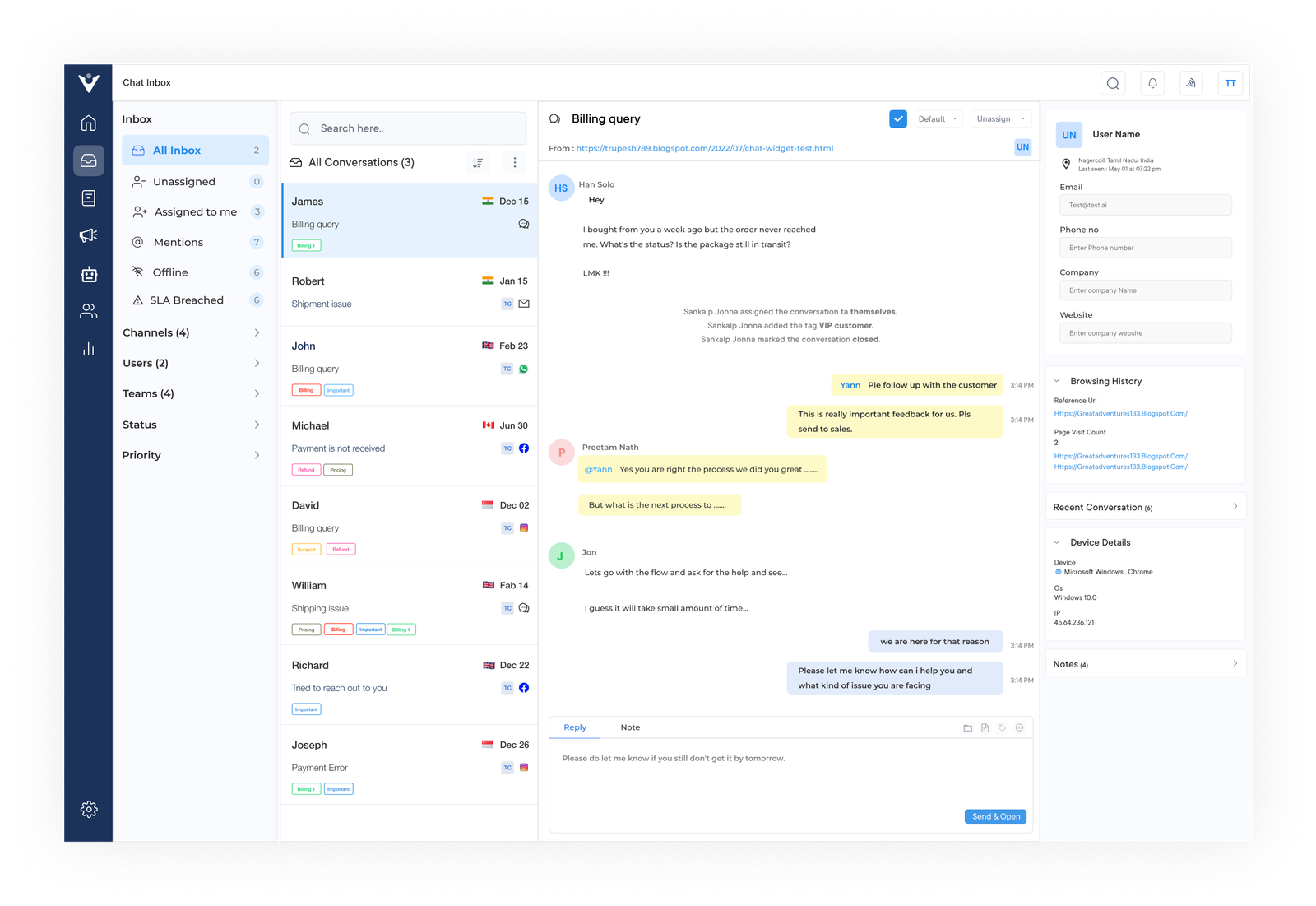
Veemo Support is an advanced help desk and customer support platform that integrates multiple channels such as email, chat, messaging and social media into one centralized dashboard. It allows customer service agents to easily manage inquiries from various channels, reducing response times . Veemo Support also offers advanced analytics and reporting capabilities, giving businesses valuable insights into customer behavior.
Key features:

Omni24 is an advanced customer experience platform that integrates multiple communication channels into a single, seamless system. It helps businesses balance human agents and bot automation, enhancing both efficiency along customer support. The platform supports live chat, email, social media, SMS and voice communications, all managed from a unified console.
Key features:
Zendesk is a customer service platform that helps businesses manage their customer interactions across multiple channels, including email, chat, phone and social media. Zendesk can help streamline your customer service processes and improve your time to resolution. It provides features like ticket management, automation and reporting. Providing your agents with the right tools can help them quickly resolve customer issues and provide a better overall experience.
Freshdesk is another popular customer service software that can help improve your time to resolution. It provides features like ticketing, automation and collaboration tools. Freshdesk offers customizable reporting, allowing you to identify improvement areas and optimize customer operations. Using Freshdesk can ensure that your team is equipped to handle customer inquiries quickly and efficiently.
The ability to solve problems quickly and efficiently is crucial in any business or personal endeavor. Prioritizing time-to-resolution can minimize downtime, improve customer satisfaction and increase the overall productivity. The key is to act promptly, communicate effectively and remain focused on reaching a successful outcome.
Every problem presents an opportunity for growth and learning. Embrace challenges with a positive mindset and approach them with determination. Mastering the art of timely resolution can help you set yourself up for success in any situation.
Measuring time to resolution is essential for businesses to improve customer satisfaction and efficiency. Tracking the time it takes to resolve customer issues can help identify areas for improvement in internal processes and customer service. The data helps businesses understand how efficiently they are handling customer inquiries and can lead to quicker resolutions in the future.
TTR is critical to the CX or customer support metric because it directly impacts customer satisfaction. The longer it takes for a customer issue to be resolved, the more frustrated the customer becomes. Ensuring quick and efficient resolution can improve their overall customer experience. It leads to increased customer loyalty and retention rates.
Time to resolution in customer service is crucial because it directly impacts customer satisfaction. The quicker an issue is resolved, the happier the customer will be. Efficiently addressing customer concerns can prevent negative reviews, retain customers and build brand loyalty. TTR also reflects the effectiveness of a company’s customer service team and operational efficiency.
Several factors can impact TTR, including the complexity of the issue, the availability of customer support agents and the effectiveness of communication. Proactive communication, well-trained representatives and streamlined processes can all help reduce TTR.
Companies can implement various strategies such as providing ongoing training and development for customer service representatives. They can implement efficient workflow processes, use technology to streamline support activities and prioritize customer inquiries based on urgency.

Market better, sell faster and support smarter with Veemo’s Conversation Customer Engagement suite of products.
Unify all your customer data in one platform to deliver contextual responses. Get a 360 degree view of the customer lifecycle without switching tools.
Connect with the tools you love to reduce manual activities and sync your business workflows for a seamless experience.
 https://veemo.io/wp-content/uploads/2024/12/customer-service-response-time.png
1256
2400
Webvision Solution
https://veemo.io/wp-content/uploads/2024/11/veemo.svg
Webvision Solution2025-10-17 10:51:142025-10-17 10:51:149 Effective Tips to Reduce Customer Service Response Time
https://veemo.io/wp-content/uploads/2024/12/customer-service-response-time.png
1256
2400
Webvision Solution
https://veemo.io/wp-content/uploads/2024/11/veemo.svg
Webvision Solution2025-10-17 10:51:142025-10-17 10:51:149 Effective Tips to Reduce Customer Service Response Time https://veemo.io/wp-content/uploads/2024/10/How-to-Create-Knowledge-Base.png
1257
2400
Vikas Sachan
https://veemo.io/wp-content/uploads/2024/11/veemo.svg
Vikas Sachan2024-10-21 12:24:342025-11-03 07:13:21How to Create a Knowledge Base in 9 Easy Steps: The Ultimate Guide
https://veemo.io/wp-content/uploads/2024/10/How-to-Create-Knowledge-Base.png
1257
2400
Vikas Sachan
https://veemo.io/wp-content/uploads/2024/11/veemo.svg
Vikas Sachan2024-10-21 12:24:342025-11-03 07:13:21How to Create a Knowledge Base in 9 Easy Steps: The Ultimate Guide https://veemo.io/wp-content/uploads/2024/02/Live-Chat-for-Sales.png
628
1200
teamwebvisionsolution@gmail.com
https://veemo.io/wp-content/uploads/2024/11/veemo.svg
teamwebvisionsolution@gmail.com2024-10-21 11:31:222025-08-06 10:22:06How to Use Live Chat for Sales? 7 Proven Ways to Grow Revenue
https://veemo.io/wp-content/uploads/2024/02/Live-Chat-for-Sales.png
628
1200
teamwebvisionsolution@gmail.com
https://veemo.io/wp-content/uploads/2024/11/veemo.svg
teamwebvisionsolution@gmail.com2024-10-21 11:31:222025-08-06 10:22:06How to Use Live Chat for Sales? 7 Proven Ways to Grow RevenueGrow Customer Relationships and stronger team collaboration with our range of products across the Conversational Engagement Suite.

 Personalization vs Customization: What’s The Difference?
Scroll to top
Personalization vs Customization: What’s The Difference?
Scroll to top